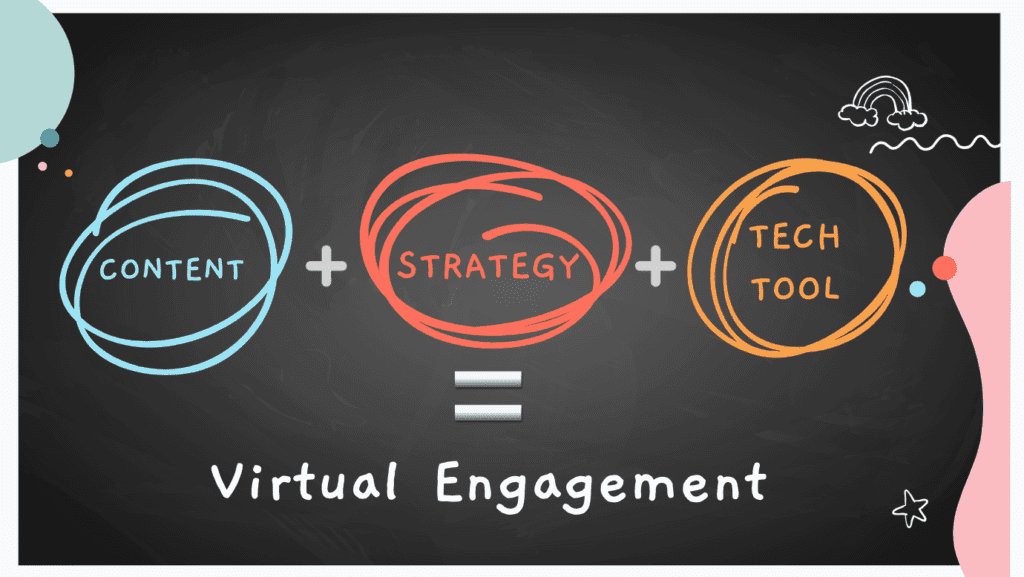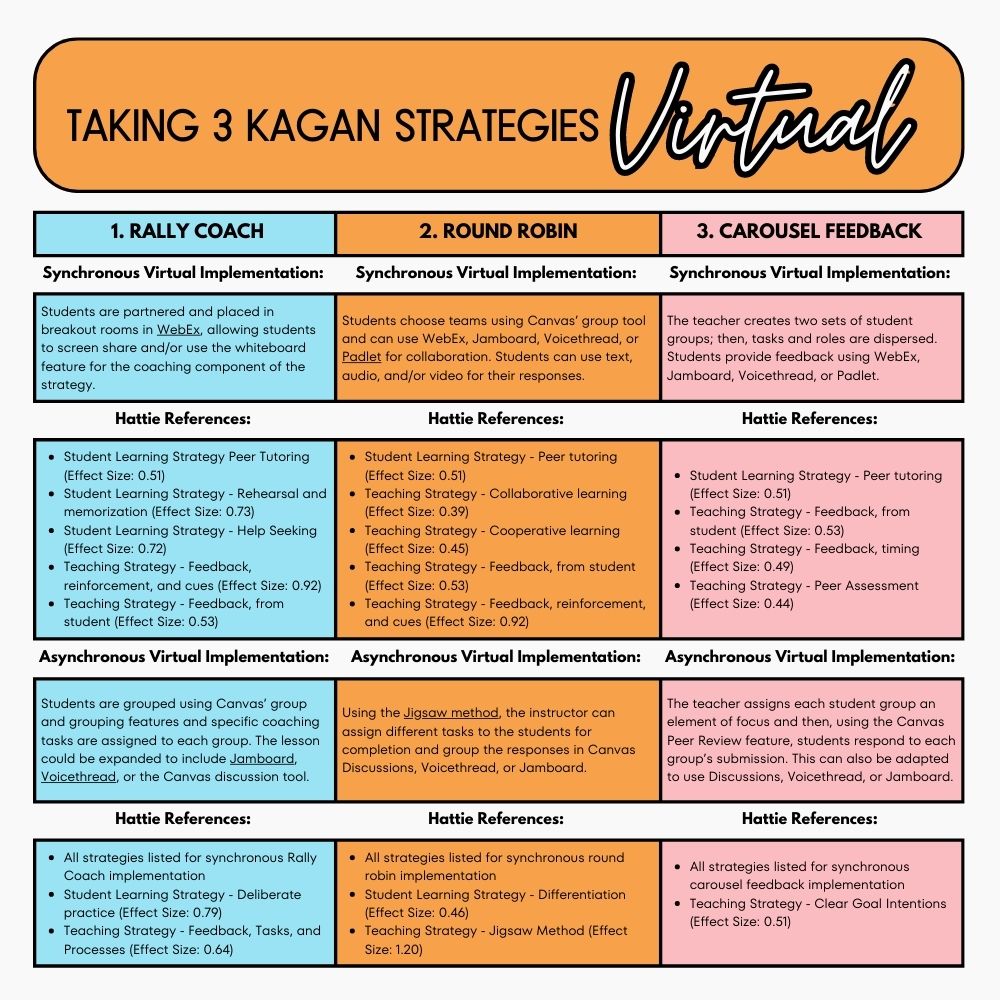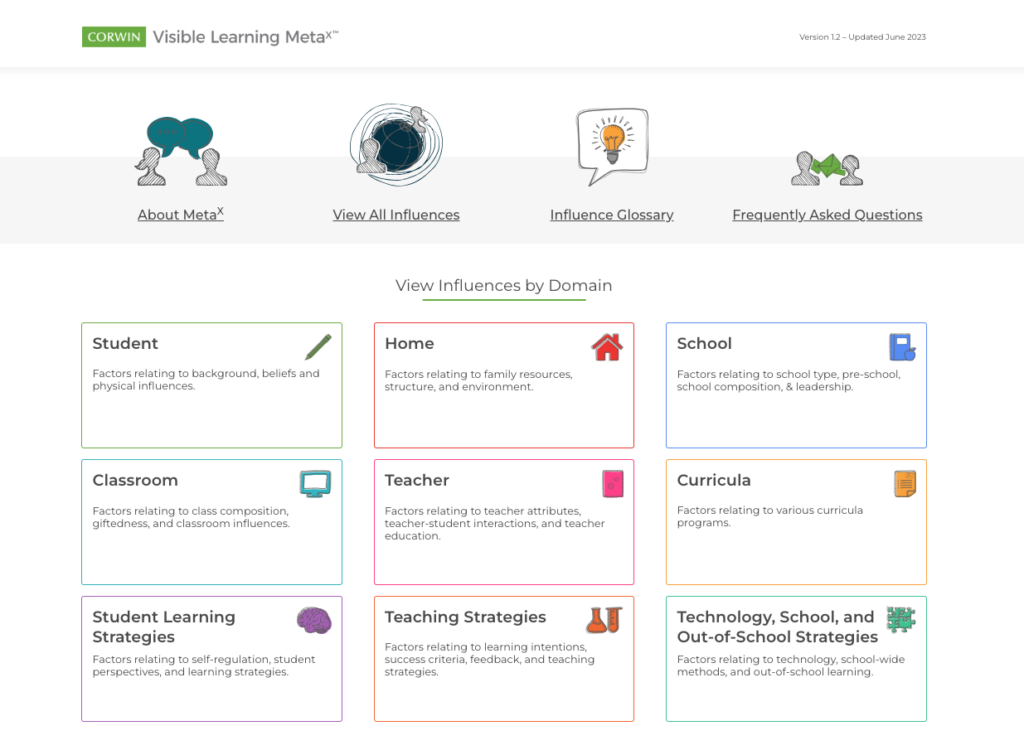The question of whether we should engage students has never been in doubt. We can engage students both online and in person in a variety of ways using gamification, interactives, and digital tools. But how do we adapt classroom strategies to virtual learning to boost engagement online? Back in 2022, our school decided to adapt seasoned strategies, like Kagan, to the 21st-century classroom in order to achieve virtual engagement. Let’s take a look at why we did it, and then how we did it.
Mixing Kagan Strategies with Hattie’s Research
Rewind to January 2022. At the time, my director was asking our instructors to increase their “teacher voice” in virtual classrooms, and the issue quickly became how to best do this. I had just been introduced to Dr. John Hattie’s amazing work, Visible Learning for Teachers. Dr. Hattie created a meta-study spanning thousands of studies to identify and share the effect size of educational techniques. Check out Evidence-Based Strategies compiled by TCEA’s Miguel Guhlin for more on why you should be using Hattie’s work.
Our teachers were already carrying the district’s legacy professional training portfolio of Kagan, SDI (Specially Designed Instruction) protocols, and other strategies. The issue always returned to: how do we adapt classroom strategies for virtual learning? Due to my recent discovery of Hattie, I wanted to be able to quantify strategies we were using in class to determine which ones would most effectively achieve student engagement success; thus, our focus was synthesized. We needed to cross-reference the Kagan strategies with Hattie’s effect sizes to select the strategies with the highest impact on student success.

By focusing on the legacy professional development strategies, we found that the instructors were more receptive to the introduction of Hattie and his effect size numbering system. So, we took the vetted, seasoned strategies from Kagan, targeted specific strategies that reflected a high effect score from Hattie, sprinkled in a few veteran instructors versed in using our LMS, Canvas, and voila – virtual engagement training for our teachers was born!
Virtual Engagement Training for Staff
Skip forward to March 2022, and we planned a half day of in-person professional development for our staff.
- First, we assigned them to mixed-curricular groups to foster collaboration and the need to share based on experiences.
- Next, we gave each group Kagan strategies on 3” by 5” cards with a written explanation of how to achieve the strategy.
- Group leaders chose three Kagan strategies to focus on out of the cards.
- Then, the groups dispersed into isolated areas to discuss the three strategies and brainstorm on how to transform them from face-to-face to virtual learning.
In their isolated areas, each group had a large piece of butcher paper to write out their ideas for a post-activity a gallery walk. We also crafted a graphic organizer to align ideas across the groups. Within that graphic organizer, we further challenged our staff to adapt the Kagan face-to-face strategy to both a synchronous lesson and an asynchronous lesson since our Academy operates under the TXVSN (Texas Virtual School Network) framework.

A Sampling of the Results of the Gallery Walk
From the professional development half day, here is a sampling of the overall results. For the purpose of this sample, I pulled the three Kagan strategies Rally Coach, Round Robin, and Carousel Feedback to show. The staff had two tasks:
- Cross-referencing these three Kagan strategies with Hattie’s research
- Determining how to apply them to both synchronous and asynchronous virtual learning

Rally Coach
Synchronous Virtual Implementation:
Students are partnered and placed in breakout rooms in WebEx, allowing students to screen share and/or use the whiteboard feature for the coaching component of the strategy.
Hattie References:
- Student Learning Strategy – Peer Tutoring (Effect Size: 0.51)
- Student Learning Strategy – Rehearsal and memorization (Effect Size: 0.73)
- Student Learning Strategy – Help Seeking (Effect Size: 0.72)
- Teaching Strategy – Feedback, reinforcement, and cues (Effect Size: 0.92)
- Teaching Strategy – Feedback, from student (Effect Size: 0.53)
Asynchronous Virtual Implementation:
Students are grouped using Canvas’ group and grouping features and specific coaching tasks are assigned to each group. The lesson could be expanded to include Jamboard, Voicethread, or the Canvas discussion tool.
Hattie References:
- All strategies listed for synchronous Rally Coach implementation
- Student Learning Strategy – Deliberate practice (Effect Size: 0.79)
- Teaching Strategy – Feedback, Tasks, and Processes (Effect Size: 0.64)
Round Robin
Synchronous Virtual Implementation:
Students choose teams using Canvas’ group tool and can use WebEx, Jamboard, Voicethread, or Padlet for collaboration. Students can use text, audio, and/or video for their responses.
Hattie References:
- Student Learning Strategy – Peer tutoring (Effect Size: 0.51)
- Teaching Strategy – Collaborative learning (Effect Size: 0.39)
- Teaching Strategy – Cooperative learning (Effect Size: 0.45)
- Teaching Strategy – Feedback, from student (Effect Size: 0.53)
- Teaching Strategy – Feedback, reinforcement, and cues (Effect Size: 0.92)
Asynchronous Virtual Implementation:
Using the Jigsaw method, the instructor can assign different tasks to the students for completion and group the responses in Canvas Discussions, Voicethread, or Jamboard.
Hattie References:
- All strategies listed for synchronous Round Robin implementation
- Student Learning Strategy – Differentiation (Effect Size: 0.46)
- Teaching Strategy – Jigsaw Method (Effect Size: 1.20)
Carousel Feedback
Synchronous Virtual Implementation:
The teacher creates two sets of student groups; then, tasks and roles are dispersed. Students provide feedback using WebEx, Jamboard, Voicethread, or Padlet.
Hattie References:
- Student Learning Strategy – Peer tutoring (Effect Size: 0.51)
- Teaching Strategy – Feedback, from student (Effect Size: 0.53)
- Teaching Strategy – Feedback, timing (Effect Size: 0.49)
- Teaching Strategy – Peer Assessment (Effect Size: 0.44)
Asynchronous Virtual Implementation:
The teacher assigns each student group an element of focus and then, using the Canvas Peer Review feature, students respond to each group’s submission. This can also be adapted to use Discussions, Voicethread, or Jamboard.
Hattie References:
- All strategies listed for synchronous carousel feedback implementation
- Teaching Strategy – Clear Goal Intentions (Effect Size: 0.51)
The overall effect of this process was positive and received well by our instructors. We saw, initially, anecdotal increases in student engagement because we were midway through the semester. Our current success data for the most recently completed term in 2023 is trending positively. Ultimately, this process of adapting classroom strategies for virtual learning is easily translated to any local education organization. I invite you to take and re-vision it, then share it. The more effective tools we skill our instructors with the better it is for all students!


